By Svetlana Murzina, Karelian Research Centre of the Russian Academy of Sciences, Petrozavodsk, Russia, and Michelle Hill, QIMR Berghofer Medical Research Institute, Brisbane, Australia
Take a journey with us across three Russian lakes and learn how Dr Polina Drozdova, Dr Ekaterina Borvinskaya and PhD student Albina Kochneva are using proteomics to understand the wonderful aquatic ecosystem. Their research starts with field-trips for sample collection, from colorful crustaceans to the not-so-colorful fish tapeworms.
Proteomics research is increasing the understanding of fundamental issues in ecology and parasitology, and also has important applications in pharmacology and agriculture, to identify new targets for antihelmintic drugs including those against tapeworms of fish.
Location 1: Irkutsk, Baikal Lake, Siberia
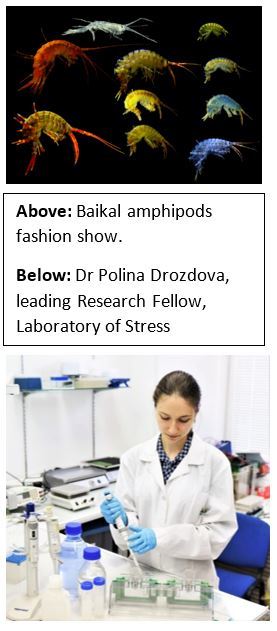 Lake Baikal is a fascinating place for anyone, and especially for those interested in molecular ecology. The deepest and oldest lake on Earth is home to 300+ species of small crustaceans (gammarid amphipods). They occupy various niches, differ in size and diet, and, most interestingly in color, which varies from transparent and milky white to bright orange, red, blue, and even dark violet.
Lake Baikal is a fascinating place for anyone, and especially for those interested in molecular ecology. The deepest and oldest lake on Earth is home to 300+ species of small crustaceans (gammarid amphipods). They occupy various niches, differ in size and diet, and, most interestingly in color, which varies from transparent and milky white to bright orange, red, blue, and even dark violet.
These bright colors triggered Dr Polina Drozdova to move across half the country to pursue Baikal research - after her first summer trip to Baikal in 2012.
Polina recently obtained support from the Russian Science Foundation to study coloration and vision of endemic Baikal amphipods.
“As a starting point, we chose a very abundant species Eulimnogammarus cyaneus that looks like a result of a natural experiment. The majority of individuals have blue bodies, exactly as the species epithet suggests, but sometimes orange individuals can be found. Importantly, if protein integrity is in any way compromised in samples of the blue animals, the color changes into orange. This change reminds the mechanism well-known for crayfish and lobsters, which turn bright red when cooked due to the degradation of carotenoid-binding proteins called crustacyanins. This similarity motivated us to search for possible proteomic differences between animals of different colors. Indeed, we found two proteins, levels of which were much higher in blue animals that in the orange ones” said Polina.
The proteomics results were astounding. Instead of crustacyanins, Drozdova’s team found the proteins share similar domains to insect pheromone/odorant-binding proteins that recognize a wide range of hydrophobic molecules.
“Even though carotenoids have not been included in this range, it was logical to suggest that the amphipod proteins (let us call them crustacyanin analogs) bind carotenoids. Indeed, further experiments supported this hypothesis” – said Polina.
These fascinating results were recent published, and Polina’s team plan to dig deeper into the molecular mechanism underlying carotenoid binding by these proteins and explore the diversity of these proteins in species with different body colors.
Location 2: Petrozavodsk, Onego Lake, Karelia
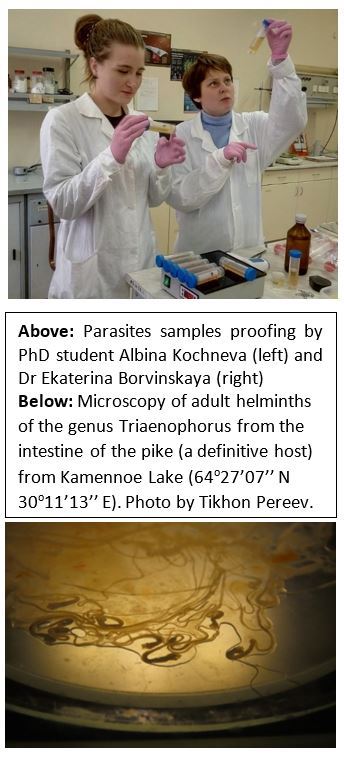 More than 4,000 km away, two young biochemists at the laboratory of environmental biochemistry IB KarRC RAS in Karelia are using proteomics to tackle a practical problem important for aquaculture and fishery sciences.
More than 4,000 km away, two young biochemists at the laboratory of environmental biochemistry IB KarRC RAS in Karelia are using proteomics to tackle a practical problem important for aquaculture and fishery sciences.
Dr Ekaterina Borvinskaya explains “Helminths of the order Bothriocephalidea are parasites of marine and freshwater teleost fish common throughout the world.”
“Like many other researchers, we work with non-model organisms for which there is no transcriptome, genomic, or proteomic data. Thus, we first decided to assemble the de novo transcriptome and annotate it for the tapeworm T. nodulosus, a common parasite of Holarctic freshwater fish. In our recent publication in Marine Genomics, we presented a functional annotation of transcripts and predicted the parasite proteome. Amazingly, in cestodes, about two-thirds of proteins is known to differ significantly in structure and, therefore, functions from proteins of other living organisms. Analysis of the T. nodulosus transcriptome revealed about a quarter of proteins with a completely unique structure even in comparison with other studied flatworm species. Such incredible biochemical diversity represents a huge parasite taxon that is very hard to get used to! However, the findings gave us an idea of a separate universe of cestodes with various unknown biologically active compounds in it”- said Ekaterina.
PhD student Albina Kochneva first joined the laboratory for her Bachelor Thesis, and has been researching parasitic worms of the genus Triaenophorus ever since. After successfully completing her Masters thesis using proteomics to study T. nodulosus and antioxidant protection enzymes of its intermediate host perch (Perca fluviatilis), Albina is now pursuing PhD in parasite proteomics.
“I became interested and did not stop wonder to how these amazing organisms adapt to life inside another organism.” - said Albina.
She studied two species of the Cestoda class which live in the same ecosystems and may infect the same definitive host (the same one fish), Triaenophorus nodulosus and Triaenophorus crassus. But, through the evolution, these tapeworms were “spatially” dispersed: T. nodulosus larvae are able to infect in the liver parenchyma of a very wide range of second intermediate hosts (different fish species) while T. crassus larvae almost exclusively inhabit the muscles of fish of Salmonidae family.
To understand the mechanisms of adaption, Albina compared the protein profiles of T. nodulosus and T. crassus at different life stages, and in different segments of the parasite body.
“To confirm the biochemical heterogeneity of different parts of the worm's body, we applied 2D-DIGE electrophoresis and LC/ESI-MS/MS together with analysts from St. Petersburg State University (St. Petersburg, Russia). We found that there is a quantitative and qualitative variability of some proteins in different parts of the parasite's body, which distinguishes and maintains their morphological and physiological characteristics.” – said Albina.
These results were presented at the 11th International Conference of Bioinformatics of Genome Regulation and Structure \ Systems Biology in 2018.
Besides these finding, it was revealed the huge amount of the secreted protein with unknown function in the head of the plerocercoid larva of T. nodulosus. This protein was completely absent in T. crassus. It was assumed that the protein might be responsible for the attachment and co-exist of T. nodulosus with its various host via the liver parenchyma. In contrast, T. crassus is unable to locate in the liver and performs specialization to its host.
Furthermore, proteomics analyses of larval stage T. nodulosus collected from the liver of different species of fish (perch Perca fluviatilis L., ruffe Gymnocephalus cernuus L. and burbot Lota lota L) revealed that the expression of some proteins at the same development stage depends on the environment (host-specific). These results support the Red Queen Hypothesis by Valen (1973) on the co-evolution of parasites and their hosts.
“For several hundred million years, the threat of infection by cestodes (tapeworms) has been a factor in the evolution of vertebrates and, definitely, to some extent, affect the formation of this taxon. This never-ending “attack and defense” processes are realized with contrivances at the molecular level resulting in inevitable reactions and inventions on both sides” – said Ekaterina
Location 3: Freshwater lakes, White Sea Basin, Kola Peninsula
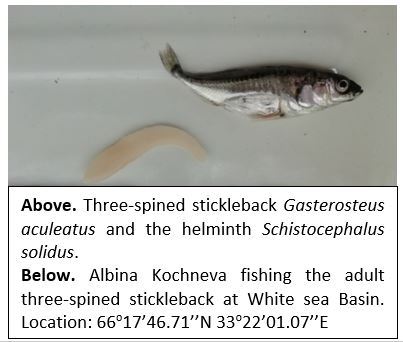 The team recently turned their attention to the highly complex lifecycle of the helminth Schistocephalus solidus (Cestoda), which journeys from host to host via the trophic net, inhabiting two categories of environment: the first order is “inside the host” or internal environment, and the second order – “the host external environment”.
The team recently turned their attention to the highly complex lifecycle of the helminth Schistocephalus solidus (Cestoda), which journeys from host to host via the trophic net, inhabiting two categories of environment: the first order is “inside the host” or internal environment, and the second order – “the host external environment”.
“The parasite transfers from its intermediate hosts - poikilothermic animals: zooplankton, a representatives of cyclopoid copepods, to fish, the three-spined stickleback (Gasterosteus aculeatus), and finally to the homeothermic animals, usually fish-eating birds.” – explains Ekaterina.
“Indeed, for the first time, the temperature-induced re-organization of proteins and lipids of S. solidus during the transition from the fish host to warm-blooded host will be carried out. 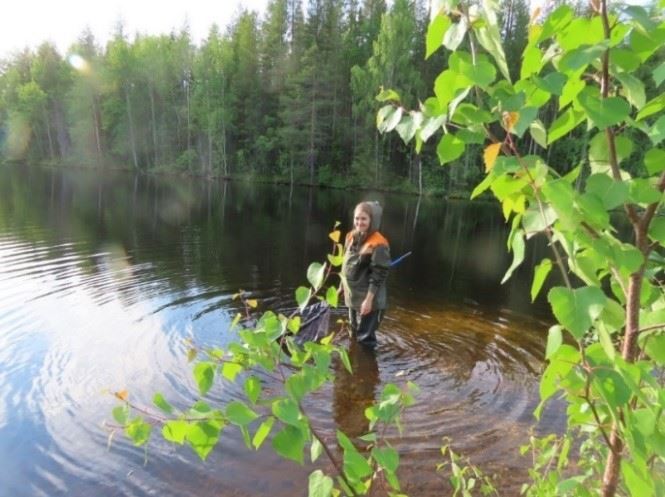 The studies have already been done at the transcriptome level but we are interested in direct registration of biomolecules of the parasite and its host, especially at the surface of the parasite body, which are regions of active metabolic exchange or communication with the host. It should be noted, that such biological task can be satisfied only by analysis of proteome and lipidome together. These molecules maintain the interactions of organisms with the environment whether in a parasitic, symbiotic, or trophic activity. The proteomic analysis will be performed with the participation of specialists from the “Human Proteome” Core Facility of the Institute of Biomedical Chemistry (IBMC, Moscow, Russia)” - said Ekaterina.
The studies have already been done at the transcriptome level but we are interested in direct registration of biomolecules of the parasite and its host, especially at the surface of the parasite body, which are regions of active metabolic exchange or communication with the host. It should be noted, that such biological task can be satisfied only by analysis of proteome and lipidome together. These molecules maintain the interactions of organisms with the environment whether in a parasitic, symbiotic, or trophic activity. The proteomic analysis will be performed with the participation of specialists from the “Human Proteome” Core Facility of the Institute of Biomedical Chemistry (IBMC, Moscow, Russia)” - said Ekaterina.
But, the research starts not in the laboratory but in the field. For this, Albina was fishing the three-spined stickleback in the freshwater lakes of the White Sea Basin in June. She needs to develop good fishing skills because three-spined stickleback adults swim fast and are hard to catch! Albina also maintains an aquaria for three-spined stickleback in the laboratory.
Apart from the essential outdoor activities, conferences and practical schools offered by HUPO, RHUPO and EuPA have also been essential aspects of Albina’s scientific life. “All these activities help me to meet friends and colleagues in the field, to tell about my results and getting valuable feedback, to follow the announcements about the recent achievements in mass-spectrometry and proteomic approaches. It is interesting to think how to apply it for my research” - tells Albina.
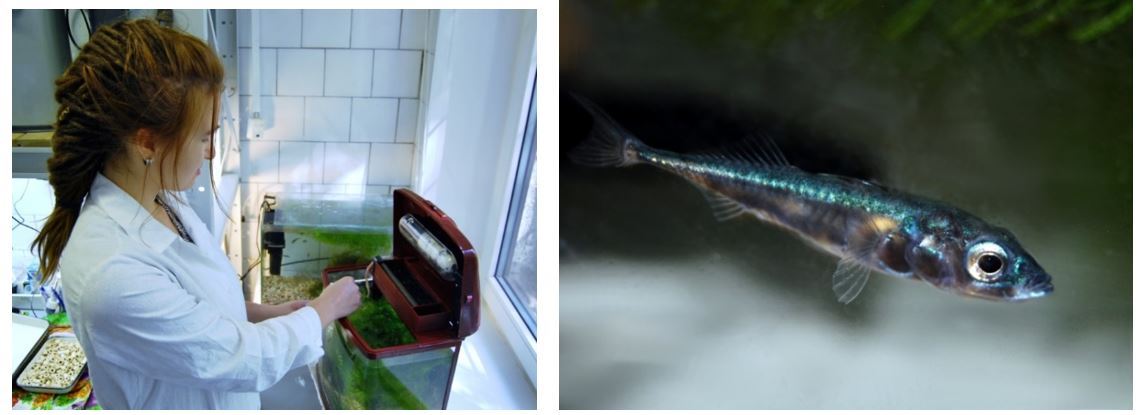
Three-spined stickleback in the aquaria. Photo by Anastasia Prokhorova.


.png)